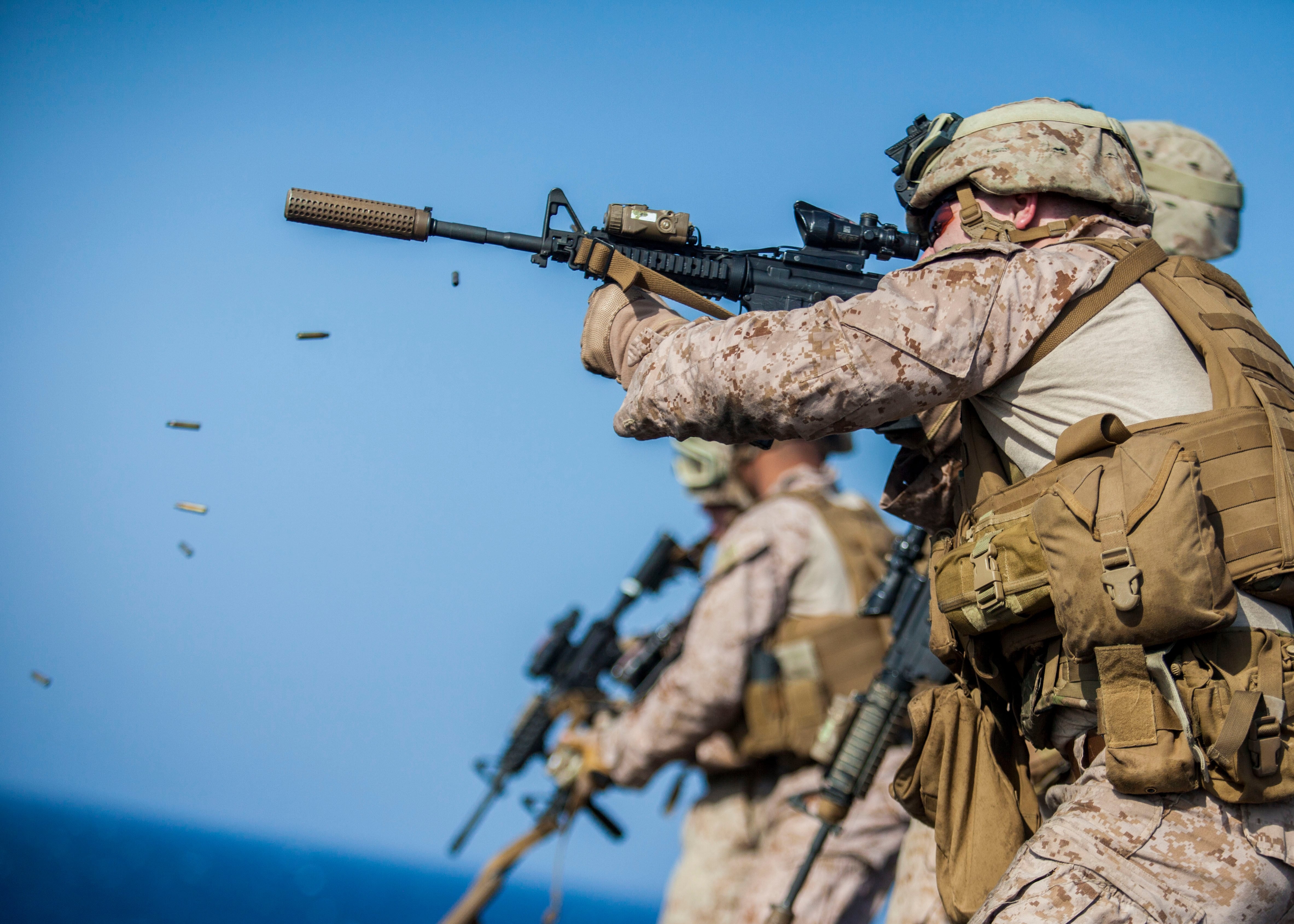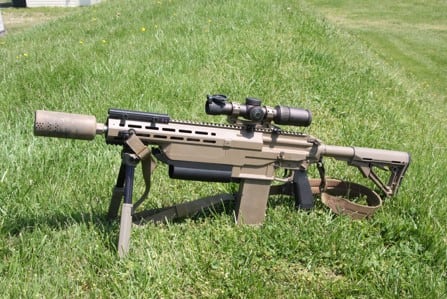Army scientists have developed a combination suppressor and muzzle brake that keeps machine guns on target and quieter on the battlefield — a boon for the tactical-level soldier’s accuracy and movement.
It’s a hybrid device that cuts half the volume at the shooter’s ear, reduces recoil by a third and drops volume down range by one quarter, said Gregory Oberlin, a small arms engineer at the Army’s Combat Capabilities Development Center Army Research Lab.
The piece of gear has been coined the “smuzzle” and can trace some of its legacy to a muzzle brake design for the 155mm howitzer.
A muzzle brake helps keep down “muzzle climb” that results from a weapon firing and gas pressure forcing the muzzle upward.
RELATED

How a solution for maintaining good aim on both a massive cannon and a handheld medium machine gun comes down to some simple aspects of physics and engineering, the developers told Army Times.
“Jumping between calibers is nothing,” said Daniel Cler, an engineer with the Army’s Armaments Center at the Combat Capabilities Development Center. “We do it all the time. A lot of times we develop large caliber muzzle devices. The principles are pretty much identical.”
Along the more than dozen years of development and patent work the three engineers worked through phases of design, tinkering with various aspects of the device.
They were working in calibers not yet selected as well, which put them in a good position when the Army determined it would pursue the 6.8mm round for its Next Generation Squad Weapon.
Past programs working with future small arms concepts involved advanced kinetics and laid the groundwork for high-performance systems that eventually fit with the upcoming NGSW, Oberlin said.
The result is a “smuzzle” that fits onto NGSW prototypes and only adds 3 inches to its overall length on a weapon expected to sustain a 600 rounds per minute firing cycle. The weight of the device is a half-pound for the NGSW, somewhat heavier for other weapons.
The Army has obtained the patent. Should it decide to move forward and field the weapon it would be manufactured by private industry, common defense department practice.
The “smuzzle” could also be used for a commercial product such as personal defense, shooting and hunting.
But what started as a way to keep big barrels on target evolved into devices to make smaller guns quieter.
And those aims are not just to be friendlier to a soldier’s ears, but also to improve tactical advantages, experts said.
Army Times has reported extensively on suppressor development in the Army and Marine Corps in recent years. Technology that’s been around for a century or more is now becoming more commonly adopted due to advances in the science, reduction in costs and new ways of implementing suppressors on the battlefield.
Weapons and tactics experts in both services told Army Times previously that the “stealth technology” for the infantry will give small units ways to confuse the enemy, providing opportunities for flanking and battlefield feint attacks even.
Marine experiments at squad and fire-team level work back in 2016 were showing similarly equipped units outperforming non-suppressed shooters in drills.
Work at the Armaments Center and the Army Research Lab kicked off in 2007, with a focus on the M240 machine gun, which fires 7.62mm and produces a lot of noise.
Standard suppressors for that caliber often couldn’t handle the heat put off by belts of rounds being fed through “the pig,” as it is affectionately known.
And the gun produces a decent recoil when compared to the standard M4 carried by most soldiers. A good muzzle brake would reduce the recoil, improving accuracy.
Over the ensuing years, Oberlin, Cler and Eric Binter, also with the Armament Center, ran many simulations to better understand what’s going on inside of the suppressor and the firearm.
Each of the three men has worked with their respective centers between 13 and 17 years, nearly all of that work being done at Picatinny Arsenal, New Jersey.
That modeling work and the subsequent 3D printed prototypes put together what is now a patented hybrid muzzle brake and suppressor.
Some of the benefits besides a reduction in sound and recoil are a cleaner shoot and a lower flash.
Suppressors are notorious for getting the gun dirty and making a larger flash than bare barrels often equipped with flash hiders.
This means a tradeoff for the soldier – lower the sound signature but increase the flash and a weapon that has to be cleaned more.
The trio of engineers was able to use those internal simulations to see all of that in a new way.

“It allowed us to look from breech to the end of the suppressor,” Cler said.
When a suppressor is on a firearm a kind of “organ piping” effect happens where the gases are trapped inside and the sound rings from the front of the suppressor back to the breech. That spreads the carbon throughout the weapon.
“That’s why they say suppressors run dirty,” Cler said.
And the endurance of the device, while not run to its limits, has fairly robust results, according to the scientists.
Pinter told Army Times that they have not tested the prototypes to failure yet but some designs have fired more than 10,000 rounds and continue to hold up to the sound, recoil and accuracy standards.
Like any hybrid device, there are tradeoffs. The suppressor knocks down sound significantly but not as much as design built only to suppress the weapon. The device has been adapted to reduce the flash better than a bare barrel, but not as well as a flash hider alone can do.
While the “smuzzle” was purpose built for machine guns, changing the dimensions and specifications is only a matter of scaling, Oberlin said.
They can put a larger device on a sniper rifle for a near whisper of a shot. But those might be too large for a house-clearing mission, which would call for a reduced length and weight, he said.
Todd South has written about crime, courts, government and the military for multiple publications since 2004 and was named a 2014 Pulitzer finalist for a co-written project on witness intimidation. Todd is a Marine veteran of the Iraq War.




